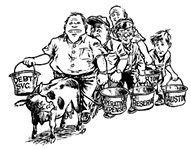MUD Wrestling
Goodman Gives Davenport the Win
By Alex de Marban, Fri., April 4, 1997
So-called environmentalist Jackie Goodman will team up with Eric Mitchell, Ronney Reynolds, and Mayor Bruce Todd to give the Davenport Municipal Utility District (MUD) and surrounding areas a city sewer hook-up. A pipeline extension? Big deal, you say. But cities don't die of natural causes. They die of seemingly minor decisions that over years add up to a grave consequence.
Slowly, the region outside Austin has grown because our city fathers in the Seventies and Eighties allowed the creation of independent districts like Davenport. Suburbanites now outnumber Austinites, and they wield enough legislative clout to have coerced Austin decision-makers into not using the city's annexation powers (see "On the Lege," p.30). This is important. If a city were a living organism, then annexation would be its food, bringing in the wealth in taxes that otherwise escapes to the suburbs. Austin can't live without it.
Gus Garcia, Beverly Griffith, and Daryl Slusher understand this and want to veto any deal that doesn't link sewer service to annexation of the MUD. After all, city policy demands it, but Jackie Goodman won't provide the fourth nay. At least not while the legislature is in session, since she fears it will pass a law to keep the city from annexing Davenport, as they did in 1995 with Circle C and Freeport's Barton Creek PUD. "We have to work on new ways to deal with others, because we no longer have the mechanism of annexation we once did," Goodman said at the council meeting last week, when the proposal was approved on the second of three votes.
Instead, the MUD will feed on the city, and the Water & Wastewater Department (WW) will eat the crumbs. The MUD board and WW staff have said that the city would make upwards of $500,000 a year from the deal. But they didn't clarify that after operational and maintenance costs, the net profit would dwindle to $10,000. After opponents scoffed at that minuscule amount during the first vote two weeks ago, WW head Randy Goss devised a new formula. By the second vote last week, he was calling the $10,000 figure a "worst-case scenario," although it was devised using the standard formula used on all WW deals. Now, he has a new formula that promises $183,333 a year. Funny how numbers change at City Hall, isn't it? How about these numbers: If Austin instead annexes the MUD, the city would net between $40-60 million more over the next 25 years, according to the city's finance department.
So in return for a pittance, the four councilmembers are doing everything to satisfy the MUD board members except feeding them grapes and fanning them. When Davenport asked for a connection to meet its schedule, an emergency meeting was slated for the day after Easter. Fortunately, the MUD was kind and found extra time in its planner to allow the council to reschedule the third and final vote for April 3.
Environmentalists like longtime Save Barton Creeker Mary Arnold believe that Davenport sewer service will facilitate a mega commercial development at that still-primarily untouched peninsula south of where the Highway 360 Bridge overlooks a bend in the Colorado River. City sewer service "has the potential to make the development happen sooner, by making it easier to get financing for the development," says Arnold. City planner Ben Luckens agrees that growth will be facilitated in the undeveloped Davenport West area, which is across 360 from the MUD. "It will be easier to develop," admits Luckens. "It could theoretically be done without city sewer, but it would be more expensive and they'd have to buy a lot of land [for irrigation]."
"I don't think that's true," counters Goodman. She says the growth will happen anyway, that the Davenport area already has approval from the city to build what it needs. In agreement is Phillip Gully, vice president of the area's majority landowner, Davenport Limited, a.k.a. Westview Development. "We're going to develop irrespective of this deal," says Gully.
But if the developers don't need city sewer, why are they reducing their planned development to secure Goodman's vote? According to Goodman, Davenport Limited President Beth Morian promised that she would eliminate 160,000 square feet of planned impervious cover. "Morian replaced two buildings with 70 houses for me," boasts Goodman.
That still leaves about 1.5 million square feet of commercial development -- or as Save Our Springs counselor Bill Bunch says, a development that's one and a half times the size of Barton Creek Mall. And that still leaves, according to a 1988 traffic count by city staff, an extra 42,000 "vehicle trips" per day. That's more people and cars to pollute the Colorado upriver from Austin, and larger crowds on our already bumper-to-bumper inner-city streets. As to whether the council will annex the MUD after the legislature leaves, don't count on it. When the city annexes an area it must pay off the area's debts. Because the MUD is going to borrow $3.2 million for the pipeline to their system -- about half of what the MUD already owes -- it will be even less financially favorable to annex the MUD.
None of this will mean much when you wake up tomorrow -- the city will look the same as it did the day before. Yes, the death of a city is a slow process of decay. The Austin region sprawls a little further, and the capital centerpiece crumbles a little faster. But you don't know until it's too late.
The New Jackie
You may have noticed that this column has recently been picking on Goodman. It's hard not to, now that she's hanging out with Todd, Mitchell, and Reynolds. Goodman was always a populist, but lately she's been going through a sort of political transformation that's made her a heroine of big business.
Remember, she recently joined forces with Todd, Mitchell, and Reynolds in reducing rates for industrial electric customers (IBM, Texas Instruments, Motorola, AMD, Applied Materials, and Seton Hospital, the first four of which form the Federation of Austin's Industrial Ratepayers, or FAIR) by $4.2 million a year. She suffered a firestorm of criticism and perhaps feels guilty: now she's trying to realign herself with the little people. Two weeks ago, she took the first step in reducing electric rates for residents and commercial customers.
With votes from Griffith, Slusher, and Garcia, Goodman ordered the Electric Utility Deptartment (EUD) to determine the cost of producing electricity with a Probability of Dispatch (POD) formula. The EUD already calculates cost of service, but it uses a watered-down formula that has lately been in question. Longtime electric industry observers, like Goodman's friend Shudde Fath, believe that the city's formula leads to unfair rates for residential and commercial customers. "It's what I call a half-assed cost of service," says Fath, a 19-year member of the Electric Utility Commission.
Management Applications Consulting recently completed a POD study based on 1995 figures. The results showed that the industrial users, after winning the reduction, would pay rates below the cost of production. But although Goodman ordered the study, she ignored the results when awarding the rate reduction, explaining that it was somehow necessary to subsidize these customers to keep 'em coming back. So that's how capitalism works. And here we thought it had something to do with making a profit.
Also, as part of the deal for reducing FAIR's rates, Goodman won a contract that will allow consumer advocate W. Scott McCollough to study the EUD. Goodman had said that in exchange for approving the rate reduction, McCollough must be allowed to do research on EUD operations. Goodman called for a $100,000 contract, but Garcia made a substitute motion that McCollough get only $39,000. The proposal won five votes, with Todd abstaining and Reynolds absent.
Ironically, McCollough was used as a pawn to ensure passage of a rate reduction that he vehemently opposed on consumers' behalf. Talk about feeling used -- McCollough might need some extra money for victims' counseling services. For all of Goodman's talk about getting a consumer advocate in on the process of making our utility more efficient, Goodman never listened to McCollough when he fought against FAIR. We can only hope she'll start now, and maybe she'll pay attention to those impending POD results too.
Got something to say on the subject? Send a letter to the editor.








